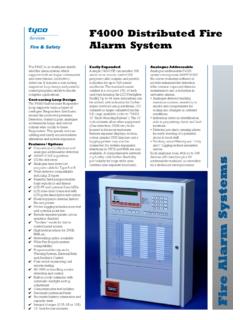Transcription of By JOHN VASTYAN Low-Loss Headers Hydronic
1 Hydronic18 June 2006 JOHNVASTYANThe installation of aparallel primary loopis widely regarded asfundamental to the optimalperformance of low-tempera-ture, multizone Hydronic systems. Gaining traction asan alternative to meticulouslyconstructed parallel primaryloops is the Low-Loss hydronicheader, now available in pre-assembled this article, several hy-dronics-industry veteransshare their thoughts on Low-Loss Hydronic Headers , whichcan offer a quick, reliable solution for a rather broadrange of a Low-Loss headerto be truly effective,overall system designmust be of a primary/secondary (P/S) con-figuration. There s an abun-dance of engineers, sys-tem designers, and in-stallers who want to get in on theprimary/secondary-piping game, but few really understand how to make it happen especially with the larger, more-complex systems, the type we typi-cally see in commercial Hydronic systems, Daniel Schlicher, owner of Watertown, DS Design Consultants, a firmspecializing in large Hydronic - and radiant-heat-system designs, to john Siegenthaler, PE,president of Utica, Appropri-Industry vets weigh in on this alternative to parallel primary loopsLow-LossOff-the-shelf Low-Loss -header solutions canbe accomplished two ways.
2 (1) for light-commercial applications up to about 250 MBH, with closely spaced tees (above)and, (2) for larger systems, with a hydraulicseparator (left). Low-Loss headerLow-loss headerHeadersPhotos courtesy of CaleffiBSEJune 2006 19ate Designs, P/S piping has beenused in the Hydronic heating indus-try for decades. The closely spacedtees of Low-Loss Hydronic Headers or the closely spaced ports of parallelprimary loops couple each second-ary circuit to a common primary, allowing circulators of differentpumping to co-exist in the same system without interfering with oneanother. Each circuit functions singularly, with no real connectionto the other circuits. You might even say that a circu-lator in a given circuit of a P/S sys-tem doesn t know the other circula-tors and piping circuits even exist, Siegenthaler P/S piping, the ability toisolate system circuits makes design-ing sophisticated multiload systemsrelatively easy, without concern forhow flow rates and pressure dropswill change as circulators turn onand off, Siegenthaler said.
3 This is aconsiderable benefit because, other-wise, circuits would compete withone another for fluid flow, greatlycomplicating heat Foley, president of Alexan-dria, Foley Mechanical,said that when a P/S system is pipedin the field, there always is the risk of the cascade effect, with eachsuccessive set of tees seeing alower temperature. Yet, with a Low-Loss header, eachsupply tapping receives the sametemperature, Foley P/S piping is bestsuited to more-complex multiload,multitemperature systems, its appli-cability can extend to simpler hy-dronic systems, Siegenthaler the designSeries primary loops are bestsuited to situations in which two or more secondary loads operatewith different supply temperatures,Siegenthaler said, adding that theCircle 13 There s an abundance of engineers, systemdesigners, and installers who want to get in on theprimary/secondary-piping game, but few reallyunderstand how to make it happen.
4 Daniel Schlicher, DS Design Consultants20 June 2006 principle is to connect thehigher-temperature secondary circuits near the beginning of a primary loop to the lower-tempera-ture secondary circuits near the arrangement, Dave Yates,owner of York, Inc., said, tends to increasethe temperature drop along the primary loop, reducing flow rate. An added benefit is that it may permit a reduction in the size of theprimary loop s piping and circula-tor(s). Sensible modifications of this basic design will accommodateany number of secondary circuits,permitting them to operate at simi-lar supply solutionCombining a hydraulic separatorand distribution manifold, low-lossheaders typically are attached to a Hydronic -heating or chilled-watersystem, permitting different heat adjustments for multiple separatezones when there is only one boileror configurationstypically are compact and easily can be designed into any type of Hydronic circuit.
5 The primary oper-ating principle is this: When a sys-tem does not contain a means of hydraulic separation between loopswith separately sized circulators, thepossibility of a tug of war betweenthe circulators is created, whichcould lead to unexpected flow key function of a low-lossheader is to provide a low-pressure-loss zone enabling both primary andsecondary circuits to be hydrauli-cally independent of one is critical to the new generationof high-flow-resistant, low-masscondensing-boiler installations because the point of lowest pressuredrop is moved from the boiler to the header s low-pressure closely spaced tees of the distribution manifold connect thesecondary circuit to the primaryloop internally so that flow in theprimary loop has little or no influ-ence on flow in the secondary circuit, preventing pump conflictand the thorny dilemma of havingdifferent loop delta-Ps.
6 Because the openings in the pri-mary chamber are so close together,there is almost no pressure differ-ence between them, and so the pres-sure differential across the internalheaders is close to zero, RogerMichaud, national sales manager forhydronic-systems supplier Caleffi,said. The pressure increase createdby a given zone circulator is almostentirely depleted by the time theflow returns back to the distributionmanifold. This arrangement pre-vents interference between theboiler circulator and whatever zonecirculators are operating. It s easyfor system designers or installers to think that isolating the primaryloop is the only thing that needs tobe done. Bob Rohr, owner of Rogersville, Show Me Radiant Heat,said: There s no question copperpipe and fittings can be used tobuild Low-Loss Headers , but a manu-factured Low-Loss header greatlyCircle 20 LOW-LOSSHYDRONICHEADERSBob Rohr of Show Me Radiant Heatconnects circulators to a courtesy of Caleffi/Grundfos22 June 2006 theprocess, re-duces laborCircle 14 LOW-LOSSHYDRONICHEADERSFIGURE ,light-commercialdesign using alow-loss additionalcirculator is notneeded becausethe boiler has , oneboiler wasinstalled chieflyfor domestic-water the whole-building remodelwas under way,the systemquickly grewbeyond its abilityto provide 2006 and time,and, most im-portantly, getsit done cor-rectly.
7 If you talkto engineersand installersabout hydronicsystems, as I doon a regular ba-sis, you ll soonCircle 23 Circle 22 LOW-LOSSHYDRONICHEADERSFIGURE 2. Here, ahydraulicseparator servesas a high-volume, Low-Loss headerfor a three-boiler,600-MBH systemthat includes anindirect-firedwater heater,which becomesthe domesticbuffer 2006 about plenty of missed P/Sand header attempts, Schlicheradded. It s not as easy as solderingpipe to build the proper header orP/S loop. You need to know how to go about it. And, modern high-head condensing boilers prettymuch dictate the need for these. Harold Kestenholz, who trainedthousands of installers during hismany years as an instructor with the Hydronics Institute, said thatwhile, A Low-Loss -header layout is great for commercial buildingsover 300,000 Btuh.
8 For somesmaller or simpler applications, it s overkill. There simply isn t enough com-plicated water flow in some systemsto install a Low-Loss header, Kesten-holz explained. All that some systems require is a header to bemade up of a foot of 1-in. copperwith two tees. A successful installation, Kestenholz continued, will happenwhen the supply and return pipingnear the boiler differ by about 20 Fon a thermometer. This will be thesame whether the boiler is or is notcondensing. Siegenthaler agreed: I see whereHarold is coming from. For exam-ple, he says a simple three-zone system with three pumped zone circuits all operating at the sametemperature and supplied by a boilerwith low flow resistance can operatejust fine if coupled with a properlysized header system.
9 Could it oper-ate with a Low-Loss header? Yes, butan additional circulator would beneeded (Figure 1). This would alsobe true for a site-built primary/secondary system. The additionalcirculator does add to installationand operating cost, and our industryseems to have developed a habit ofusing lots of circulators that at sometimes are not necessary. I m tryingto get them to discern when P/S isnecessary vs. when it could be donewith more conventional header piping. Both methods definitelyhave their place. When used with high-mass cast-iron or steel boilers, zero-balancemanifolds save time and eliminateunexpected problems, Kestenholzsaid, adding he also favors their usewith low-mass boilers. My concern, chiefly with low-mass boilers, Kestenholz said, isthat the burner input be controlledto prevent overheating when onlysome zones are open.
10 Here, the installer could create additional mass in the primary or bypass loopto absorb heat when only a fewzones are open. Circle 16 LOW-LOSSHYDRONICHEADERS28 June 2006 key challenge, of course, isthat low-mass boilers do not have aplace to put large heat inputs. If aboiler is sized improperly, this couldlead to the overfiring of a buildingload and, as a result, hammering andsizzling with or without a goodbypass. If you have a 300,000-Btuh copper-tube boiler, you d betterhave some place to safely direct230,000 Btus right now, Kesten-holz said. You don t want 70,000 Btus going into an indirect waterheater with all the other zones shutoff in the summer, unless you havesome means to anticipate tube over-heating right now.







